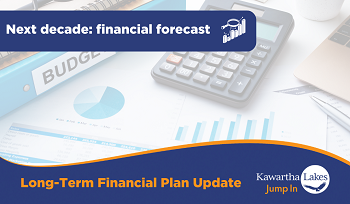Kawartha Lakes Outlines 10-Year Financial Plan: Investments, Services, and Tax Impacts

Kawartha Lakes – At the August 26, 2025 Council meeting, City staff provided a presentation on the updated Long-Term Financial Plan (LTFP) for 2026 to 2035. The Plan, currently being developed, will be included with the 2026 Budget and Business Plan. It outlines how the municipality will balance both operating and capital investments in infrastructure, community services and workforce needs, while maintaining financial stability through reserve and debt strategies.
Mayor Elmslie commented, "This plan makes it clear: the costs of running and growing our City are increasing, and we need to invest now to grow responsibly. By carefully managing taxes, debt, and reserves, we’re making responsible decisions that protect both today’s residents and future generations."
Clear strategy to address rising costs
The LTFP projects an average property tax increase of 7% per year over the next decade. Of this increase, 5% will fund day-to-day operations such as emergency response, snow clearing, recreation and waste management, while 2% is dedicated to renewing and upgrading infrastructure such as roads, bridges, and community facilities. The Dedicated Capital Levy is continuing along a path toward meeting 70% of tax-supported state-of-good-repair capital needs within the 10-year plan. Other reliable funding sources would meet the remaining 30% of those needs.
“The proposed levy increase is essential to achieving the City’s ultimate goal of long-term sustainability and self-reliance,” noted Adam Found, Manager of Corporate Assets. “It will also reduce our reliance on borrowing and help stabilize tax rates and user fees as we continue to grow.”
Notable tax-supported capital projects to address state-of-good-repair needs forecasted by 2035 include:
- Fenelon Falls bridge ($17.5M over 2029 - 2030)
- St. Patrick Street (Lindsay) - Queen St. to North end ($4.8M in 2026)
- Platform aerial truck ($3.9M in 2028)
- Oakwood Paramedic Station ($4.9M in 2029)
- Emily-Omemee Arena lobby and dressing rooms ($6.6M in 2026)
Notable tax-supported expansionary capital projects forecasted by 2051 include:
- Colborne St. bridge and intersections ($21.0M over 2026 - 2027)
- Somerville Third Concession Road and bridge ($38.5M over 2031 - 2032)
- Kent St. - Victoria Ave. to Angeline St. ($11.4M over 2029 - 2030)
- Central Roads Operations Depot ($20.4M over 2028 - 2029)
- Landfills cells ($44.8M over 2025 - 2044)
- Fire Headquarters and Lindsay Fire Hall ($32.3M over 2029 - 2030)
- Paramedic Headquarters and Fleet Centre ($50.0M over 2025 - 2027)
- Pioneer Park and Ops Park ($12.4M over 2026 - 2028)
- Victoria Manor Long-Term Care Home ($111M over 2034 - 2035)
- Social Housing ($233M over 2025 - 2035)
- Cultural Centre ($54.4M over 2029 - 2031)
Major pressures
Several key factors are driving the City’s financial needs:
- Workforce costs: Staff wages and benefits represent about 40% of the City’s budget. New positions have been allocated each year to maintain and enhance services as the population grows.
- Capital projects: Upcoming projects include bridge replacements, arena upgrades, new paramedic and fire facilities and housing. Major projects include the Victoria Manor Long-Term Care Home redevelopment and a new Cultural Centre.
- Debt management: The City is committed to keeping debt repayments within 10% of annual revenues while using borrowing as a tool for large projects.
- Building reserves: A stronger reserve strategy will help stabilize taxes, reduce reliance on borrowing, and prepare for unforeseen needs.
“This plan is about balancing and strengthening the City’s financial sustainability,” said Sara Beukeboom, Director of Corporate Services. “We need to keep services running, invest in the infrastructure residents rely on every day, and prepare for growth. At the same time, we’re working to manage taxes responsibly so that the City remains financially strong for years to come.”
Growing the tax base
The financial plan assumes continued growth, with 500 new homes built annually until 2031, and 600 per year until 2036. New development will expand the tax base and help offset costs.
The City will also review user fees, such as water and wastewater rates, landfill fees, transit and recreation fees and various permits, to ensure services are funded fairly and reduce the reliance on property taxes. This will move user fees toward full cost recovery in some areas, such as waste management, and toward market-competitive rates in others, such as arenas.
The LTFP takes into account a number of master strategies and plans, including: Growth Management Strategy, Transportation Master Plan, Transit Master Plan, Active Transportation Master Plan, Trails Master Plan, Development Charges Study and the Housing and Homelessness Plan. All documents can be viewed on our website on the Reports, Studies and Plans page.
Adjusting for limited grant funding
The plan assumes little increase in provincial and federal grants, meaning the bulk of new funding must come from local sources. The City will continue to pursue grant opportunities but will plan conservatively to ensure stability of tax levy and user fee requirements.
The draft 2026 Budget will be presented this fall, and the LTFP will be updated annually with Council approval, following the annual budget process. Follow the 2026 budget process on our Budget and Finance webpage: www.kawarthalakes.ca/budget
Have your say! Weigh in on the proposed increased infrastructure levy, and other ways that Council could prioritize discretionary funds for the 2026 Budget, before August 30, 2025. Use the interactive Budget Tool today!
- 30 -
Media are welcome to visit our Media Portal for high resolution images.
Contact Us
Kawartha Lakes
P.O. Box 9000, 26 Francis Street
Lindsay, ON, K9V 5R8
Telephone: 705-324-9411
Toll free at 1-888-822-2225
After-hours emergencies: 1-877-885-7337




